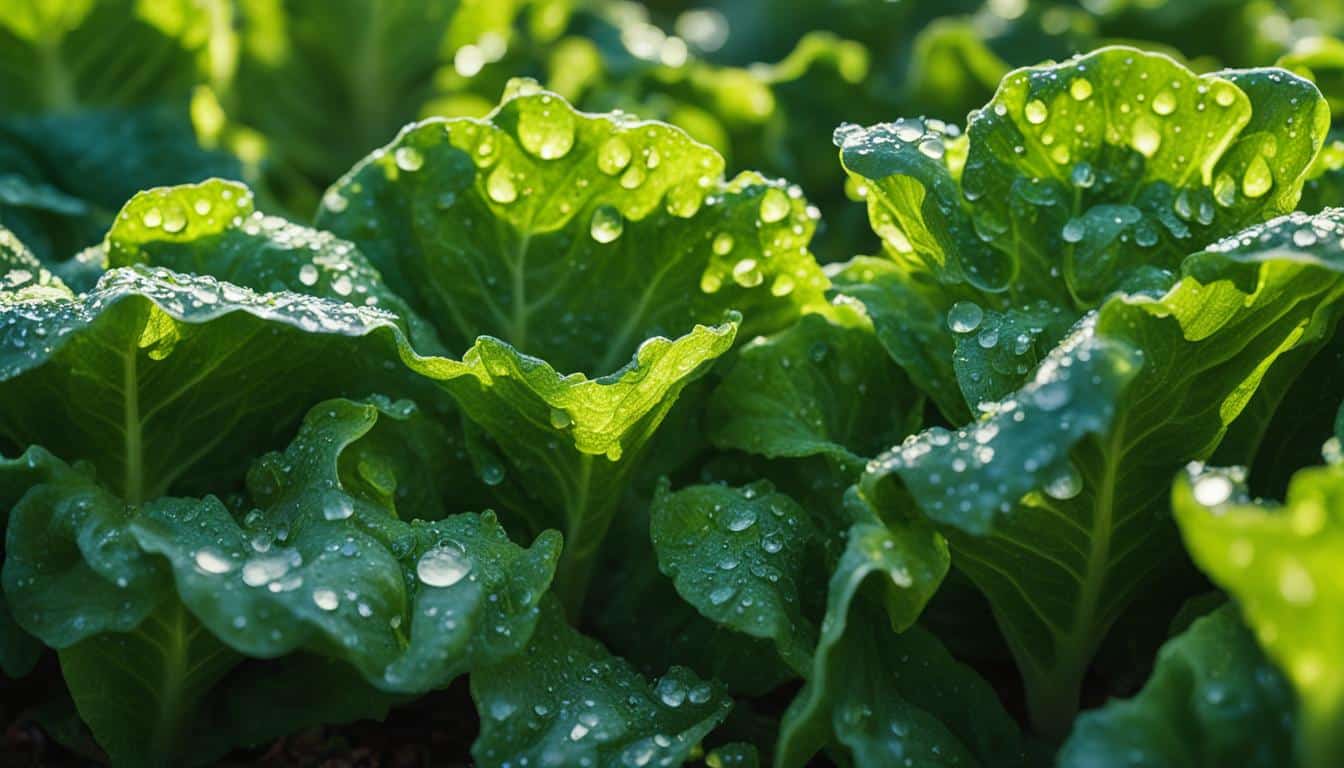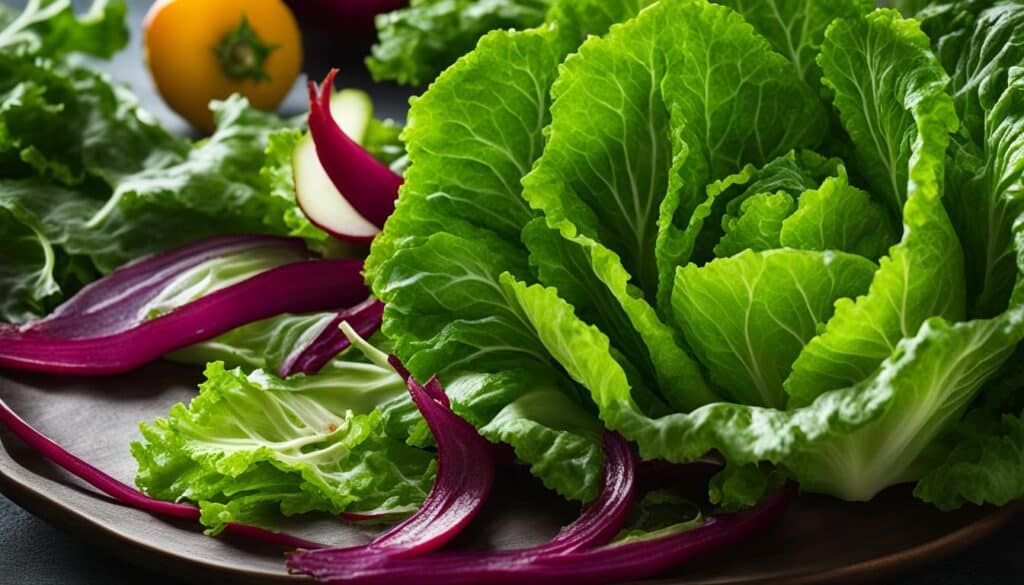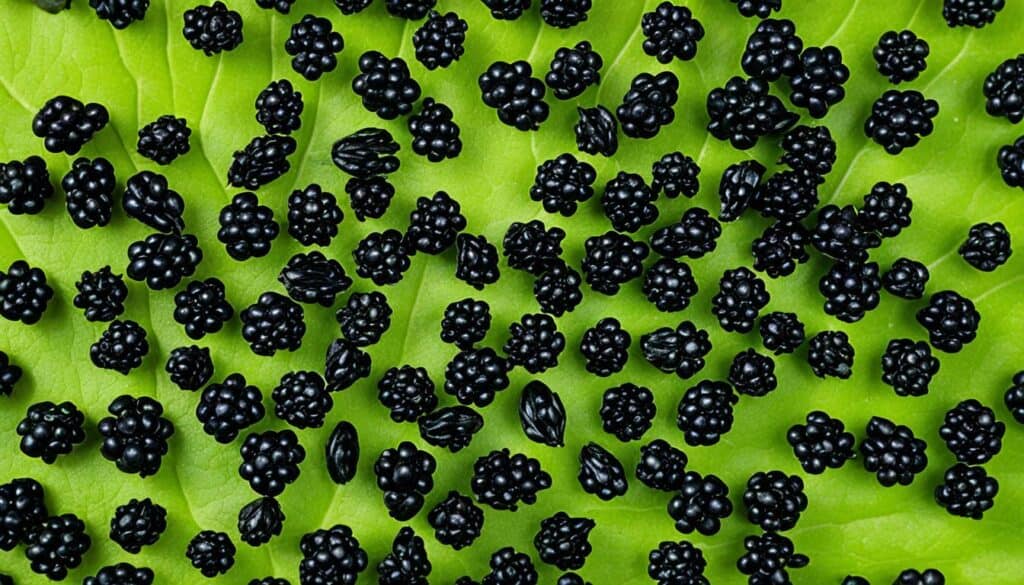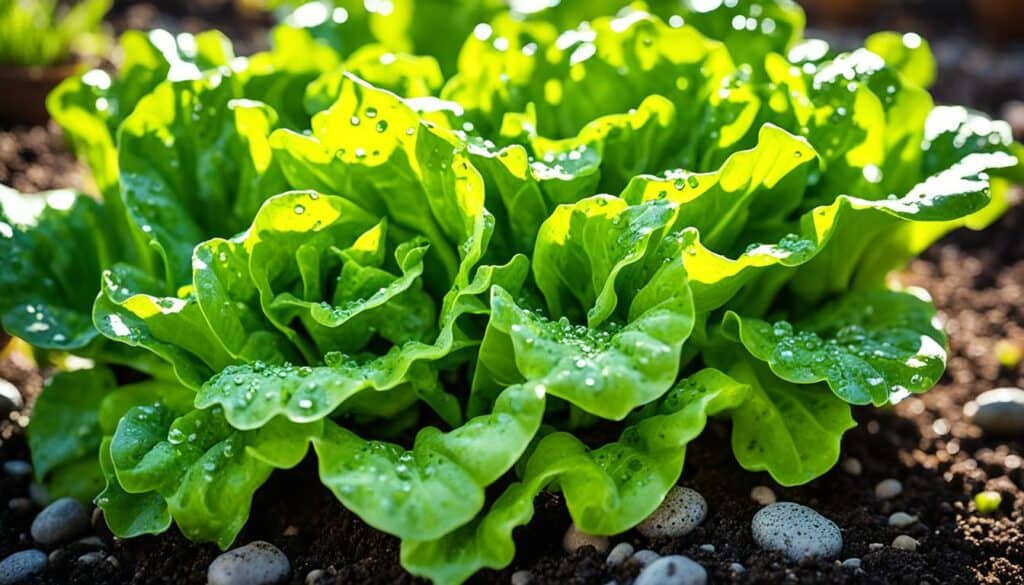Did you know that Black Seeded Simpson Lettuce, an heirloom variety of lettuce, has been around since the 19th century? This resilient lettuce is not only packed with flavor but also offers a multitude of benefits for home gardeners and backyard farmers. From its fast maturity to its versatility in the kitchen, Black Seeded Simpson Lettuce is a must-have in any garden.
Key Takeaways:
- Black Seeded Simpson Lettuce is an heirloom variety that has been enjoyed for centuries.
- It is a versatile lettuce that can withstand various weather conditions and infestations.
- Its light-green, juicy leaves are perfect for salads and other dishes.
- Black Seeded Simpson Lettuce is popular among home gardeners who prefer open-pollinated and non-GMO seeds.
- Stay tuned to discover why this lettuce is a great choice for your garden, how to grow it, and the best ways to use it!
Why Choose Black Seeded Simpson Lettuce for Your Garden?
Black Seeded Simpson Lettuce is a great choice for your garden for several reasons. Firstly, it is an heirloom lettuce, meaning it has been passed down through generations and is known for its taste and quality. Secondly, it is an organic variety, which is important for those who prefer to grow their own food without the use of chemicals. Lastly, it is well-suited for home gardening and backyard farming, as it is easy to grow and maintain.
If you’re looking to add a delicious and nutritious green to your garden, Black Seeded Simpson Lettuce is the perfect choice. Its rich history as an heirloom variety guarantees a flavorful and rewarding experience. Growing this organic lettuce in your garden allows you to enjoy fresh and healthy salad greens without any harmful chemicals or pesticides. Whether you’re an experienced gardener or just starting out, Black Seeded Simpson Lettuce is a versatile and fuss-free option.
With its fast maturity and ability to withstand various weather conditions, Black Seeded Simpson Lettuce is resilient and reliable, making it an ideal choice for home gardening and backyard farming. Its vibrant green leaves add a beautiful touch to any garden, while its crisp texture and delicate flavor make it a staple in salads and other dishes.
“I love growing Black Seeded Simpson Lettuce in my garden. Its heirloom status gives it a unique flavor that you won’t find in other lettuces. Plus, the fact that it’s organic means I can enjoy it without any worries about harmful chemicals. It’s truly a rewarding and delicious experience.” – Emily GreenThumb, Home Gardener
Whether you have limited gardening space or ample room in your backyard, Black Seeded Simpson Lettuce is a versatile and adaptable plant that can thrive in various environments. It grows well in containers, raised beds, and traditional garden rows, making it accessible to all types of gardeners. Its low maintenance requirements make it an excellent choice for beginners and those with busy lifestyles.
By choosing Black Seeded Simpson Lettuce for your garden, you’ll not only enjoy the satisfaction of growing your own food but also reap the nutritional benefits of this leafy green. Packed with vitamins and antioxidants, it’s a wholesome addition to your diet.
So why wait? Start growing Black Seeded Simpson Lettuce in your garden today and relish in the joys of homegrown, organic, and delicious salad greens.
How to Grow Black Seeded Simpson Lettuce
Growing Black Seeded Simpson Lettuce is a rewarding experience for home gardeners. This variety is known for its resilience and ease of cultivation, making it an ideal choice for those interested in home gardening and backyard farming. Here are some essential tips on how to grow organic Black Seeded Simpson Lettuce:
- Preferred Growing Conditions:
- Full sun: Black Seeded Simpson Lettuce prefers full sun exposure, but it can tolerate partial shade, especially in hotter climates.
- Well-drained and loose soil: Ensure that the soil is well-drained, cool, and loose. The ideal pH range is between 6.2 and 6.8.
- Sowing seeds: You can sow the seeds directly into your garden in early spring or start them indoors 3-4 weeks before transplanting.
- Spacing: Space the plants about 6 inches apart, with 12 inches between rows, to allow adequate room for growth.
- Moist soil: Keep the soil consistently moist, but avoid overwatering, as excessive moisture can lead to disease and rot.
- Regular watering: Provide regular watering to ensure healthy growth and prevent wilting.
- Timing: Harvest the lettuce when it reaches the desired size, usually around 45-60 days after planting.
- Leaf harvesting: You can harvest individual leaves throughout the growing cycle, allowing the plant to continue producing.
- Head harvesting: For full heads of lettuce, harvest when the heads are still plump and tender, before a stem starts to form.
Growing Black Seeded Simpson Lettuce is a straightforward process that can yield fresh and delicious organic lettuce for your salads and other dishes. By following these guidelines, you can enjoy the bountiful rewards of your home garden.
“Growing Black Seeded Simpson Lettuce in my backyard has been a joy. The process is simple, and the rewards are delicious. It’s such a versatile lettuce that adds a refreshing crunch to any dish!” -Lettuce Lover
Tips for Harvesting Black Seeded Simpson Lettuce
When it comes to harvesting black seeded simpson lettuce, timing is key. Depending on your preferences, you can harvest this garden lettuce at different stages of its growth. Here are some tips to help you get the best out of your black seeded simpson lettuce harvest:
- Microgreens: If you prefer tender and young greens, harvest the lettuce when it reaches a height of around 3-4 inches. This typically occurs within 2 weeks after germination. Microgreens are perfect for adding a burst of fresh flavor to your dishes.
- Baby Greens: For a slightly more mature option, wait until the black seeded simpson lettuce is approximately 28-35 days old. At this stage, the leaves will have developed a bit more, but they will still be tender and flavorful. Baby greens are great for salads and sandwiches.
- Mature Leaves: Throughout the growing cycle, you can harvest individual mature leaves of the black seeded simpson lettuce. However, be mindful of any signs of bitterness, especially if the plant is preparing to bolt to seed. Harvest the mature leaves before a stem starts to form.
- Full Heads: If you prefer whole heads of lettuce, harvest the plants when they are still plump and tender, before a stem begins to develop. This is the classic form of black seeded simpson lettuce and is perfect for creating salads with a satisfying crunch.
Remember to handle the leaves gently during the harvest process to avoid bruising or damaging them. Enjoy the fresh flavors and vibrant colors of your homegrown black seeded simpson lettuce in your favorite salad creations!
“Harvest your black seeded simpson lettuce at different stages depending on your taste and recipe requirements. From microgreens to full heads, there’s a harvesting option for every lettuce lover!”
Best Uses for Black Seeded Simpson Lettuce
Black Seeded Simpson Lettuce is a versatile and delicious variety that can be used in various ways to elevate your culinary creations. Its tender and juicy leaves are perfect for salads, adding a refreshing and crisp element. But its uses go beyond salads. Here are some creative ways to incorporate Black Seeded Simpson Lettuce into your meals:
Sandwiches and Wraps
Layer the lettuce leaves onto your favorite sandwiches and wraps to enhance the flavors and textures. Its mild and slightly sweet taste complements a variety of fillings, from savory meats to tangy sauces.
Spring Rolls
Add a fresh and vibrant touch to your homemade spring rolls by including Black Seeded Simpson Lettuce. The delicate leaves will provide a delightful crunch, making every bite a satisfying experience.
Easy Recipes featuring Black Seeded Simpson Lettuce
| Recipe | Description |
|---|---|
| Classic Caesar Salad | An iconic salad that combines the crispiness of Black Seeded Simpson Lettuce with creamy Caesar dressing, Parmesan cheese, and crunchy croutons. |
| Asian Lettuce Wraps | A flavorful dish where Black Seeded Simpson Lettuce leaves serve as a healthy and low-carb alternative to traditional wraps, filled with a savory meat or veggie filling. |
| Avocado Salad with Black Seeded Simpson Lettuce | A refreshing salad that combines the creaminess of ripe avocados with the crunch of Black Seeded Simpson Lettuce, drizzled with a zesty lemon vinaigrette. |
Experiment with different combinations and dressings to create your own unique salad recipes. Whether it’s a simple side salad or a complex gourmet creation, Black Seeded Simpson Lettuce will add a touch of freshness and vibrancy to every dish.
Note: The image above showcases the beautiful and vibrant Black Seeded Simpson Lettuce, which can be used in various ways to elevate your meals.
Saving Black Seeded Simpson Lettuce Seeds
If you want to save the seeds from your Black Seeded Simpson Lettuce, it is important to allow the plants to go to seed. This means letting the lettuce bolt and produce flowers. Once the flowers have blossomed and dried up, you can harvest the seed heads. Rub the seed heads between your hands to release the seeds. Remove any chaff or debris from the seeds and store them in a cool, dry place for future planting. Saving seeds from heirloom varieties like Black Seeded Simpson Lettuce ensures that you can continue to grow them in your garden year after year.
Where to Buy Black Seeded Simpson Lettuce Seeds
If you’re looking to grow your own delicious black seeded simpson lettuce, you’ll need to find a reliable source for high-quality seeds. There are several options available for purchasing black seeded simpson lettuce seeds to ensure a successful and rewarding gardening experience.
Online Seed Companies
One convenient way to get your hands on black seeded simpson lettuce seeds is by browsing through online seed companies. These companies offer a wide range of heirloom and organic seeds, including black seeded simpson lettuce. Simply visit their websites, search for black seeded simpson lettuce seeds, and place your order. Make sure to read customer reviews and check the company’s certifications for non-GMO and organic seeds to ensure their quality and integrity.
Garden Centers
If you prefer a more hands-on approach, visiting your local garden center is a great option. Many garden centers carry a variety of vegetable seeds, including black seeded simpson lettuce. Look for a reputable garden center in your area and inquire about their selection of lettuce seeds. The staff can provide valuable advice and recommendations based on your specific gardening needs.
Local Farmers’ Markets
Supporting local farmers is not only a sustainable choice but also a great way to access fresh and high-quality produce. Visit your nearest farmers’ market and check if any local farmers or vendors offer black seeded simpson lettuce seeds for sale. They may have a limited selection, but buying seeds directly from farmers ensures the authenticity and quality of the seeds while supporting local agriculture.
Table — Comparison of Black Seeded Simpson Lettuce Seed Suppliers
| Seed Supplier | Seed Type | Seed Quality | Average Price |
|---|---|---|---|
| Online Seed Company A | Non-GMO and Organic | Excellent | $5.99 per packet |
| Garden Center B | Non-GMO | Good | $3.99 per packet |
| Local Farmers’ Market C | Organic | Excellent | $4.50 per packet |
As you can see from the table above, there are different options available for purchasing black seeded simpson lettuce seeds. Each supplier has its own advantages and considerations. It’s essential to compare factors such as seed type, quality, and price before making a decision. Remember to choose seeds that align with your preferences for non-GMO and organic options, ensuring a healthy and sustainable gardening experience.
Whether you choose to buy online, visit a garden center, or support local farmers, obtaining black seeded simpson lettuce seeds is the first step towards growing your own delicious lettuce. With the right seeds in your hands, you’re ready to embark on the exciting journey of cultivating this versatile and nutritious vegetable in your own garden.
Growing Black Seeded Simpson Lettuce: Common Problems and Solutions
While cultivating Black Seeded Simpson Lettuce can be a rewarding experience, it is also important to be aware of common problems that may arise in your garden. By understanding these challenges and implementing preventive measures, you can ensure the health and vitality of your lettuce crop.
Pests: Aphids and Slugs
Aphids and slugs are two common pests that can impact the growth of Black Seeded Simpson Lettuce. Aphids are small insects that feed on the leaves, causing curling, wilting, and stunted growth. Slugs, on the other hand, leave behind slime trails and chew holes in the leaves.
To minimize these pests’ presence, keep your garden clean and free of weeds, as they provide hiding places. Additionally, encourage natural predators like ladybugs and birds to visit your garden, as they help control aphid populations. Consider using organic pest control methods such as insecticidal soaps or neem oil if infestations become severe.
Diseases: Powdery Mildew and Lettuce Rot
Powdery mildew is a fungal disease that appears as a white powdery coating on the leaves. It can hinder photosynthesis and stunt plant growth. Lettuce rot, caused by excessive moisture, can lead to root and stem decay.
To prevent these diseases, ensure adequate air circulation around your lettuce plants by providing enough space between them. Water the plants at the base to avoid wetting the leaves, as excess moisture creates favorable conditions for disease development. Regularly monitor your plants for any signs of disease and promptly remove infected foliage to prevent further spread.
Expert Tip: Maintaining Proper Watering Techniques
Proper watering is essential for the health and productivity of Black Seeded Simpson Lettuce. Overwatering can lead to root rot, while underwatering can result in stunted growth and bitter-tasting leaves.
Water your lettuce plants consistently, ensuring that the soil remains moist but not waterlogged. Avoid overhead watering, as it can contribute to disease development. Consider using a drip irrigation system or watering at the base of the plants to deliver water directly to the roots.
| Problem | Symptoms | Prevention | Treatment |
|---|---|---|---|
| Aphids | Curling leaves, wilting, stunted growth | Keep garden clean, encourage natural predators | Insecticidal soaps, neem oil |
| Slugs | Slime trails, holes in leaves | Clear weeds, create barriers like eggshells or copper tape | Handpicking, diatomaceous earth |
| Powdery Mildew | White powdery coating on leaves | Ensure proper air circulation, avoid overhead watering | Remove infected foliage, apply fungicide if necessary |
| Lettuce Rot | Root and stem decay, plant wilting | Avoid overwatering, ensure well-draining soil | Improve drainage, remove infected plants |
By being proactive in addressing these common issues and employing proper gardening techniques, you can maintain a thriving Black Seeded Simpson Lettuce crop in your home garden or backyard farm.
Conclusion
Black Seeded Simpson Lettuce is a versatile and resilient variety of lettuce that is well-suited for home gardening and backyard farming. Its rich history as an heirloom lettuce makes it a favorite among gardeners. I highly recommend adding this lettuce variety to your garden, whether you are an experienced gardener or just starting out.
With proper care and attention, you can enjoy the fresh and delicious taste of Black Seeded Simpson Lettuce in your salads and other dishes. Its light-green leaves are crisp and juicy, perfect for adding a refreshing element to any meal. This organic lettuce variety is a must-have for any garden, especially for those who prefer open-pollinated and non-GMO seeds.
Growing Black Seeded Simpson Lettuce in your own backyard allows you to have full control over its cultivation. You can ensure that it is grown without the use of chemicals and enjoy the satisfaction of harvesting your own salad greens. Embrace the joy of home gardening and experience the rewards of backyard farming with this amazing lettuce variety. Happy gardening!










Leave a Reply